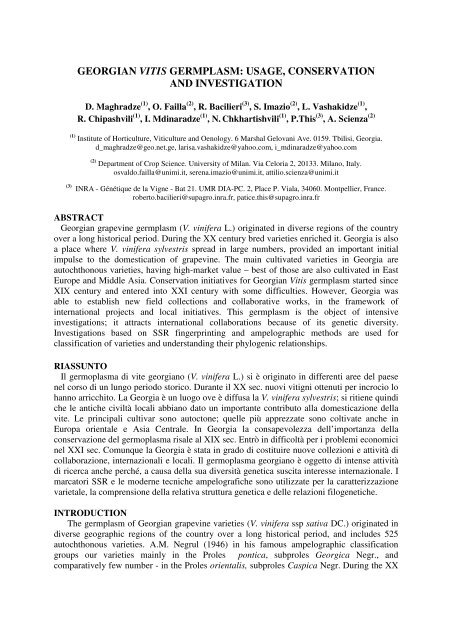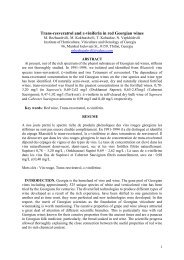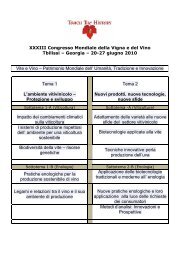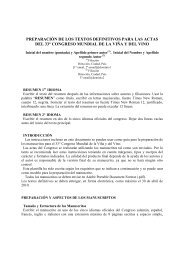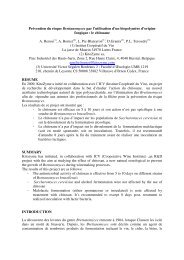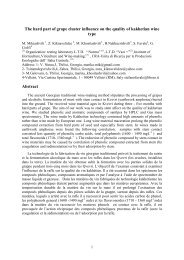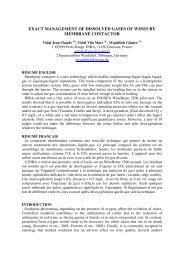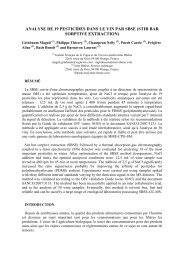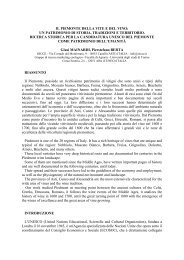georgian vitis germplasm: usage, conservation and ... - ResearchGate
georgian vitis germplasm: usage, conservation and ... - ResearchGate
georgian vitis germplasm: usage, conservation and ... - ResearchGate
Create successful ePaper yourself
Turn your PDF publications into a flip-book with our unique Google optimized e-Paper software.
GEORGIAN VITIS GERMPLASM: USAGE, CONSERVATION<br />
AND INVESTIGATION<br />
D. Maghradze (1) , O. Failla (2) , R. Bacilieri (3) , S. Imazio (2) , L. Vashakidze (1) ,<br />
R. Chipashvili (1) , I. Mdinaradze (1) , N. Chkhartishvili (1) , P.This (3) , A. Scienza (2)<br />
(1) Institute of Horticulture, Viticulture <strong>and</strong> Oenology. 6 Marshal Gelovani Ave. 0159. Tbilisi, Georgia.<br />
d_maghradze@geo.net.ge, larisa.vashakidze@yahoo.com, i_mdinaradze@yahoo.com<br />
(2) Department of Crop Science. University of Milan. Via Celoria 2, 20133. Milano, Italy.<br />
osvaldo.failla@unimi.it, serena.imazio@unimi.it, attilio.scienza@unimi.it<br />
(3)<br />
INRA - Génétique de la Vigne - Bat 21. UMR DIA-PC. 2, Place P. Viala, 34060. Montpellier, France.<br />
roberto.bacilieri@supagro.inra.fr, patice.this@supagro.inra.fr<br />
ABSTRACT<br />
Georgian grapevine <strong>germplasm</strong> (V. vinifera L.) originated in diverse regions of the country<br />
over a long historical period. During the XX century bred varieties enriched it. Georgia is also<br />
a place where V. vinifera sylvestris spread in large numbers, provided an important initial<br />
impulse to the domestication of grapevine. The main cultivated varieties in Georgia are<br />
autochthonous varieties, having high-market value – best of those are also cultivated in East<br />
Europe <strong>and</strong> Middle Asia. Conservation initiatives for Georgian Vitis <strong>germplasm</strong> started since<br />
XIX century <strong>and</strong> entered into XXI century with some difficulties. However, Georgia was<br />
able to establish new field collections <strong>and</strong> collaborative works, in the framework of<br />
international projects <strong>and</strong> local initiatives. This <strong>germplasm</strong> is the object of intensive<br />
investigations; it attracts international collaborations because of its genetic diversity.<br />
Investigations based on SSR fingerprinting <strong>and</strong> ampelographic methods are used for<br />
classification of varieties <strong>and</strong> underst<strong>and</strong>ing their phylogenic relationships.<br />
RIASSUNTO<br />
Il germoplasma di vite <strong>georgian</strong>o (V. vinifera L.) si è originato in differenti aree del paese<br />
nel corso di un lungo periodo storico. Durante il XX sec. nuovi vitigni ottenuti per incrocio lo<br />
hanno arricchito. La Georgia è un luogo ove è diffusa la V. vinifera sylvestris; si ritiene quindi<br />
che le antiche civiltà locali abbiano dato un importante contributo alla domesticazione della<br />
vite. Le principali cultivar sono autoctone; quelle più apprezzate sono coltivate anche in<br />
Europa orientale e Asia Centrale. In Georgia la consapevolezza dell’importanza della<br />
conservazione del germoplasma risale al XIX sec. Entrò in difficoltà per i problemi economici<br />
nel XXI sec. Comunque la Georgia è stata in grado di costituire nuove collezioni e attività di<br />
collaborazione, internazionali e locali. Il germoplasma <strong>georgian</strong>o è oggetto di intense attività<br />
di ricerca anche perché, a causa della sua diversità genetica suscita interesse internazionale. I<br />
marcatori SSR e le moderne tecniche ampelografiche sono utilizzate per la caratterizzazione<br />
varietale, la comprensione della relativa struttura genetica e delle relazioni filogenetiche.<br />
INTRODUCTION<br />
The <strong>germplasm</strong> of Georgian grapevine varieties (V. vinifera ssp sativa DC.) originated in<br />
diverse geographic regions of the country over a long historical period, <strong>and</strong> includes 525<br />
autochthonous varieties. A.M. Negrul (1946) in his famous ampelographic classification<br />
groups our varieties mainly in the Proles pontica, subproles Georgica Negr., <strong>and</strong><br />
comparatively few number - in the Proles orientalis, subproles Caspica Negr. During the XX
century new bred varieties enriched this <strong>germplasm</strong>. Georgia, a country of the South<br />
Caucasus, is also a place where Vitis vinifera ssp sylvestris Gmel. strives <strong>and</strong> is found in large<br />
numbers (Ramishvili, 1988); this is believed to have provided an important initial impulse to<br />
the domestication of grapevine, by the old civilisations here.<br />
The main cultivated varieties in Georgia are autochthonous varieties, having high-market<br />
value (Census, 2004). The best varieties like ‘Rkatsiteli’, ‘Saperavi’, ‘Tavkveri’ <strong>and</strong> others<br />
are cultivated in East Europe, Middle Asia <strong>and</strong> other countries of the Caucasus.<br />
Awareness of importance <strong>and</strong> <strong>conservation</strong> initiatives for Georgian Vitis <strong>germplasm</strong> started<br />
since XIX century (Staroselskii, 1893), passed the best period in XX century <strong>and</strong> entered into<br />
XXI century with some difficulties linked to the economic situation of the Country. However,<br />
Georgia was available to establish new field collections <strong>and</strong> collaborative works, in the<br />
framework of international projects <strong>and</strong> local initiatives. Besides, some of the autochthonous<br />
varieties are preserved in foreign collections, bringing a reciprocal interest between local <strong>and</strong><br />
foreign researchers.<br />
Beside the <strong>conservation</strong>, the grapevine <strong>germplasm</strong> is the object of intensive investigations in<br />
various scientific fields; it attracts international collaborations because of its genetic diversity<br />
(Vouillamoz et. al. 2006; Maghradze et al. 2009b). Investigations based on SSR fingerprinting<br />
<strong>and</strong> modern ampelographic methods are used for classification of varieties, for underst<strong>and</strong>ing<br />
their genetic structure <strong>and</strong> the phylogenic relationships with the World’s <strong>germplasm</strong>.<br />
The aim of this work was a multidisciplinary characterisation <strong>and</strong> evaluation of Georgian<br />
grapevine <strong>germplasm</strong> including autochthonous varieties <strong>and</strong> wild vines, demonstration of its<br />
importance for domestic <strong>and</strong> foreign viticulture <strong>and</strong> winemaking.<br />
Particular target of this work is to give a description of the Georgian <strong>germplasm</strong> platform<br />
through a molecular approach based on SSR profiling of most interesting wine/table<br />
cultivated grapes <strong>and</strong> representatives of wild populations. Two different types of approaches<br />
were carried out: i) analysis <strong>and</strong> description of the genetic structure of Georgian grapevines<br />
basing on the characterization of wild <strong>and</strong> cultivated collected samples; ii) Comparison of<br />
data obtained in the previous investigation (Maghradze et al. 2009a) with data obtained by<br />
genotyping at 20 SSR loci the 2305 grapevines conserved in the Institut National de la<br />
Recherche Agronomique (INRA, France) grape <strong>germplasm</strong> repository of Domaine de Vassal<br />
(INRA Domain de Vassal, 2004). The combined used of these two approaches were<br />
considered valuable in describing in a complete way both the structure of Georgian viticulture<br />
<strong>and</strong> its spread in other Countries.<br />
MATERIALS AND METHODS<br />
Plant materials: Georgian autochthonous grapevine varieties (V. vinifrera ssp sativa DC.)<br />
from 5 field collections (Vashlijvari, Skra, Telavi (Georgia), Gorizia (Italy) <strong>and</strong> Vassal<br />
(France) were included in our research. One hundred <strong>and</strong> thirty nine cultivars were selected<br />
for DNA investigation as representatives of supposed Georgian native grape <strong>germplasm</strong>. At<br />
the same time, in this research, 22 wild grapevine (V. vinifera ssp sylvestris Gmel.) were also<br />
added.<br />
Ampelography <strong>and</strong> Ampelometry: Harmonized ampelographic descriptors of OIV (1983,<br />
2007), IPGRI (1997), GENRES 081 <strong>and</strong> UPOV (1999) were used for ampelographic,<br />
agronomic <strong>and</strong> cytologal characterization of vine organs. Eighty one parameters of leaves, 3<br />
parameters of bunch, 2 parameters of berries <strong>and</strong> 3 parameters of seeds were obtained by the<br />
software “SuperAmpelo” (Soldavini et al. 2007).<br />
Phenology: One hundred thirty four varieties were tested in a field collection, located in<br />
Gorizia. Phenological timing, according to Baggiolini’s scale (in Coombe, 1995), <strong>and</strong>
technological ripening profiling, in the three year period 2004-2006 has been recorded.<br />
Seasonal weather courses were representative of local climate (Maghradze et al. 2010).<br />
Anthocyanin Analysis: Eighty nine colored accessions from Gorizia collection <strong>and</strong> 10<br />
European cultivars was analyzed by HPLC technique according to Mattivi et al. (1990).<br />
Cytological analysis: The Karnua’s solution 3:1 (ethanol: acetic acid) was used for fixation<br />
of cells. Common methods for cytological analyses (Pausheva, 1970; Chkhartishvili et al.<br />
2006) were used for investigation of pollen <strong>and</strong> stigma morphology, structure <strong>and</strong> parameters.<br />
Thirty cultivars <strong>and</strong> clones of grapevine were discovered in this work. The analysis was<br />
conducted at the Institute of Horticulture, Viticulture <strong>and</strong> Oenology by L. Vashakidze (2006).<br />
SSR genotyping: Samples of young leaves were collected for each accession during the<br />
active growing seasons or from woody cuttings green house grown. The DNA was extracted<br />
using a commercial kit (Qiagen DNeasy Plant Kit). Twenty nuclear SSR loci were chosen<br />
basing on the work of Doligez <strong>and</strong> coworkers (2006). These loci, selected for their quality <strong>and</strong><br />
distribution across the 19 grapevine chromosomes, were detected on an automated ABI<br />
Prism® 310 Genetic Analyzer (Applied Biosystems – Life Technologies, Foster City, CA,<br />
USA). Alleles were scored by eye using GeneMapper 3.10 (Applied Biosystems – Life<br />
Technologies) <strong>and</strong> allele sizes were recorded in bp with two decimal precision allele sizes<br />
were st<strong>and</strong>ardized to the sizes of reference varieties.<br />
For structure <strong>and</strong> paternity analysis, the data of the Georgian varieties <strong>and</strong> wild genotypes<br />
were compared against the SSR dataset of the Vassal collection of INRA (France). These<br />
data, obtained by Lacou et al. (in prep.) on the same set of 20 SSR, <strong>and</strong> presented by Le Cunff<br />
et al. (2008), comprised 2262 cultivars. A number of common reference varieties presenting<br />
alleles spanning all the diversity was used, following the method of This et al. (2004), to<br />
adjust allele length between the dataset obtained in the two laboratories (University of Milan<br />
<strong>and</strong> INRA), so to make the two dataset harmonized <strong>and</strong> comparable.<br />
Data analysis:<br />
Analysis of the genetic structure of Georgian grapevine <strong>germplasm</strong>: The apparent isolation of<br />
Georgian <strong>germplasm</strong> makes this viticulture particularly interesting to be investigated, for this<br />
reason we used the software Identity (Wagner <strong>and</strong> Sefc, 1999) to calculate the number of<br />
alleles (n), the expected (H e ) <strong>and</strong> observed (H o ) heterozygosity, the estimated frequency of<br />
null alleles (r) <strong>and</strong> the probability of identity (P.I.). To describe the structure of these samples<br />
<strong>and</strong> to perform a study on allele frequencies <strong>and</strong> characterization, Genetic distances were<br />
calculated by the Nei's (1978) genetic distance using the Microsat software (Minch et al.<br />
1997).<br />
Comparison between Georgian samples <strong>and</strong> Vassal <strong>germplasm</strong> collection <strong>and</strong> Parentage<br />
analysis: To verify the contribution of Georgian <strong>germplasm</strong> platform to viticulture a<br />
parentage analysis was carried out with the software FaMoZ adapted to grape (Gerber et al.<br />
2003; Di Vecchi Staraz et al. 2007). Possible parents determined by logarithm of odds (LOD)<br />
scores <strong>and</strong> significance thresholds were probed among the 2305 cultivars previously<br />
characterized with the set of 20 SSR markers. Likelyhood ratios were calculated according to<br />
Bowers <strong>and</strong> Meredith (1997) from alleles frequencies based on this set of data. To verify the<br />
kind of the most probable relationships among the Georgian material <strong>and</strong> between this <strong>and</strong> the<br />
Vassal <strong>germplasm</strong> collection ML-Relate software was used (Kalinowski et al. 2006) . This is<br />
a computer program calculating maximum likelihood estimates of relatedness <strong>and</strong> relationship<br />
for codominant genetic data. ML-Relate is designed for microsatellite loci, <strong>and</strong> can<br />
accommodate null alleles. ML-Relate is useful for discriminating among four common<br />
pedigree relationships: unrelated (U), half-siblings (HS), full-siblings (FS), <strong>and</strong> parent-
offspring (PO). For each of these kind of relationships the likelihood is given helping in<br />
categorize the analyzed accessions.<br />
Statistical Analysis: The obtained data were processed by uni- <strong>and</strong> multivariate statistical<br />
analysis as described in the Results section. Data were analyzed using SPSS (V. 14.0)<br />
statistical program.<br />
The period of investigation: ranged from 2003 to 2009.<br />
RESULTS AND DISCUSSION<br />
Usage: Main direction of Georgian viticulture is winemaking. The list of st<strong>and</strong>ard wine<br />
cultivars in Georgia contains 34 ones (from total number of 48 cultivars), including 27 old<br />
autochthonous varieties (Law, 1998). They cover most of vineyards within country <strong>and</strong> can<br />
produce high quality wines, highly rated by wine-tasting panels in different countries of the<br />
world. Important Georgian varieties are ‘Rkatsiteli’, ‘Saperavi’, ‘Tavkveri’, ‘Mtsvane<br />
Kakhuri’ ‘Tsolikouri’, ‘Ojaleshi’, ‘Krakhuna’, ‘Alex<strong>and</strong>rouli’, ‘Chinuri’ <strong>and</strong> others.<br />
During XX century Georgian autochthonous varieties of grapevine were involved in<br />
breeding programs in Georgia <strong>and</strong> other countries abroad. As a result, the successful<br />
realization of 193 new bread varieties from 13 Georgian native varieties in 16 different<br />
countries was achieved (Vakhtangadze et al. 2010).<br />
Conservation: at the beginning of XXI century the <strong>conservation</strong> of Georgian native<br />
<strong>germplasm</strong> had some progress after the regress of the 90 th of the XX century: Vashlijvari<br />
collection (Tbilisi, Georgia) with 300 accessions was established in the framework of the<br />
international project “Conservation <strong>and</strong> Sustainable use of grapevine genetic resources in the<br />
Caucasus <strong>and</strong> Northern Black Sea region” in 2003-2005. Based on the materials of this<br />
collection the Institute of Horticulture, Viticulture <strong>and</strong> Oenology was able to establish other<br />
three field collections in Telavi (573 accessions), Skra (440) <strong>and</strong> Vachebi (312) in 2008.<br />
Other three new collections were set up by Saguramo “Centre for Grapevine <strong>and</strong> Fruit Tree<br />
Planting Material Propagation” (about 400 accessions), “Kindzmarauli” winery <strong>and</strong> “Shumi”<br />
winery (149). Two new collections were established in Italy by the University of Milan.<br />
Except this positive tendency, viticulture in Georgia is threatened by genetic erosion: only a<br />
few numbers of local varieties are still cultivated in spite of the available; wide number of<br />
indigenous breeding varieties not yet included in <strong>germplasm</strong> collections or on the brink of<br />
extinction due to preservation only in a single collection. Few wild vines are preserved in<br />
collections. This is the reason why proper <strong>conservation</strong> management <strong>and</strong> activities for<br />
Georgian grapevine <strong>germplasm</strong> is still actual.<br />
Investigation:<br />
Ampelography: Ampelographic cards based on IPGRI <strong>and</strong> OIV descriptors for grapevine<br />
were prepared for varieties ‘Gorula’ (138 descriptors), ‘Gorula clone No23’ (138), ‘Tavkveri’<br />
(114) <strong>and</strong> ‘Satsuravi’ (96). 150 ampelographic cards with 56 characters were completed in the<br />
Gorizia collection. Local varieties were described in Vashlijvari (216 varieties, 14<br />
descriptors), Telavi (27 var., 17 descript.) <strong>and</strong> Skra (28 var., 20 descript.) collections.<br />
Based on the inventory of Georgian grape collections a database of native varieties was<br />
established in 2004. Eight hundred seventy-five accessions available in the collections were<br />
described by the IPGRI-FAO Multicrop Passport Descriptors <strong>and</strong> data were published in the<br />
Vitis International Variety Catalogue (http://www.vivc.bafz.de/index.php). In this year the<br />
publication of ampelographic descriptors with photos was also started in this database.
A new ampelography of Georgian native varieties was published in Italian language (Del<br />
Zan, Failla, Scienza, 2004, 2009). The book was printed in two editions, including complete<br />
description of 45 varieties <strong>and</strong> pictures of 105 varieties.<br />
Phenology: Average multi-year phenological data demonstrates that the timing of bud break<br />
<strong>and</strong> flowering was slightly later in respect to Western European varieties. Veraison timing<br />
was clearly later showing a very wide range. Also the ripening time was on average late.<br />
Ripening profiling was ample. Georgian varieties according to time of maturation can be<br />
grouped in four main clusters: the earlier group, harvested in 269-278 Julian days<br />
(September), includes only 9 varieties while other ones mainly were harvested in 280-300<br />
Julian days (October). Maximum sugar accumulation was 25.93 Brix (19.4 in average),<br />
minimum total acidity 3.5 g/l (8.9 in average) <strong>and</strong> PH was between 2.8-3.5 (3.1 in average).<br />
Antocianins: Statistical data processing allowed classifying the sampled varieties into four<br />
main groups, out of which two were sub-divided into sub-groups, for a total of ten groups<br />
(Rossoni et al. 2007; Maghradze et al, 2009a). We found very high level of total anthocyanins<br />
(>3000 mg/kg of berry) in four accessions (‘Otskhanuri Sapere’, ‘Ojaleshi’, ‘Saperavi<br />
Grdzelmtevana’ <strong>and</strong> ‘Argvetula’). Through a cluster analysis it was possible to classify all the<br />
samples in classes of phenotypic proximity. In particular, ‘Rkatsiteli Vardisperi’ showed the<br />
only presence of delphinidin 3-monoglucoside free <strong>and</strong> represent an isolate class of particular<br />
interest for pharmacological application of this compound.<br />
Cytology: The chromosome number of somatic cells basically are diploid (2n=38), but<br />
among those five tetraploid, triploid <strong>and</strong> diploid-tetraploid clones of ‘Tsolikouri’, ‘Rkatsiteli’,<br />
‘Saperavi’ <strong>and</strong> ‘Gorula’ varieties were discovered. The process of mitosis proceeds normally<br />
with sufficient high activity of cell division (4.8-8.6%). The frequency of abortive cells varies<br />
according to varieties (0.3-2.3%) <strong>and</strong> presents as in the pre-synthetic (G 1 ), as in the postsynthetic<br />
(G 2 ) phases of Mitosis.<br />
The pollen parameters of hermaphrodite varieties are: length of air-dry pollen is 21.1-38.8<br />
µm, width is 14.7-23.0 µm, <strong>and</strong> diameter of colored in carmine grains is 8.1-27.9 µm. The<br />
pollen basically has three pores. Pollen of female varieties is pore-less, but infrequently,<br />
three-pores pollen grains have been also discovered (0.4-2.5%). Hermaphrodite varieties are<br />
high fertile (69.2-98.9%). Single number of fertile pollen (0.6±0.4%) was reported among<br />
pollen of female varieties. Pollen germination varies 40-90% <strong>and</strong> their vitality is 7-10 days.<br />
The number of stoma is 135-227 per 1mm 2 of leaf. Their parameters are: length 191-295 µm,<br />
width 16.3-21.5 µm, <strong>and</strong> the number of chloroplasts per stoma is 27.8-21.5.<br />
Microsatellite analysis (genetic structure of Georgian <strong>germplasm</strong>): The 135 accessions<br />
produced 130 distinct profiles when analysed at the 20 considered SSR loci. As already<br />
recorded for grapevine species the probability of having different individuals with the same<br />
profile at all loci is quite low (P.I.=2.95x10 -7 ), so identical genotypes over all loci can be<br />
considered identical by descent <strong>and</strong> not by chance. Same considerations can be extended to<br />
other genetic parameters such as the allele number (n), allele size range, expected (H e ) <strong>and</strong><br />
observed (Ho) heterozygosity <strong>and</strong> probability of identity (P.I.).<br />
The IDENTITY software was also used to define synonyms; 4 pairs of redundant genotypes<br />
were found in this work at the 20 investigated loci.<br />
Basing on SSR markers Genetic distances among analysed samples were computed <strong>and</strong><br />
results show, confirming the considerations made basing on observed heteozigosity <strong>and</strong> allele<br />
frequencies, the good level of genetic richness observed in the frame of the selected samples.
This result is quite interesting because this part of Caucasus is considered a cradle of<br />
grapevine domestication <strong>and</strong> it has been for a long time isolated from commercial <strong>and</strong> plant<br />
exchanges with elsewhere especially with the most important European Countries in grape<br />
growing <strong>and</strong> wine making. Despite isolation, <strong>and</strong> maybe thanks to this, Georgian grapevine<br />
<strong>germplasm</strong> seems to avoid the loss of genetic assortment, thus it seems to be particularly<br />
interesting in the frame of genetic <strong>and</strong> agronomic studies. On the other side, a strict<br />
connection of Georgian grapes <strong>and</strong> the Terroir, is clearly evidenced by genetic distances<br />
results; basing on these, in fact, we can observe a marked separation of all analysed material<br />
in two different groups. More interesting is the observation that the samples are grouped<br />
basing on their geographical belongings (eastern or western Georgia). The correlation<br />
between genetic <strong>and</strong> geographic distances is well known <strong>and</strong> already explored <strong>and</strong> discussed<br />
in grapevine European assortments <strong>and</strong> is one of the evidence for the existence of different<br />
areas of domestication. Twenty three wild accessions were also inserted in the analysis <strong>and</strong>, as<br />
already seen in the viticulture of other European Regions, also in this case the wild accessions<br />
are well distinguished from the cultivated compartment. Even if in this case the separation<br />
seems not to be as great as the one identified in other Countries.<br />
On the wild samples side, the molecular fingerprint has revealed very few mistakes or interspecific<br />
crossings in the pool of collected samples <strong>and</strong> no cases of parent offspring<br />
relationship among the two (wild <strong>and</strong> cultivated) compartments.<br />
Comparison between Georgian samples <strong>and</strong> Vassal <strong>germplasm</strong> collection <strong>and</strong> Parentage<br />
analysis: The second part of our work was devoted to the comparison of Georgian <strong>and</strong> other<br />
Countries viticultures. In this context we have decided to consider the INRA Grapevine<br />
<strong>germplasm</strong> repository established in Vassal, because of the high number of samples from<br />
several Vitis species worldwide distributed.<br />
For this reason Famoz <strong>and</strong> ML-relate softwares were used to evaluate the probability of<br />
existing relationships (parent/offspring, full siblings, half siblings, unrelated) among Georgian<br />
material <strong>and</strong> other grapevine accessions collected in Vassal.<br />
The results of this huge research confirmed that the most interesting putative relationships<br />
were the ones involving Georgian samples <strong>and</strong> the Countries belonging to the former Soviet<br />
Union or neighbour Countries. Almost none of the most important cultivated grapes seem to<br />
have a direct relationship with Georgian material. This is also confirmed by the PCA. As<br />
shown in the PCA representation Georgian material is quite distant, under the genetic point of<br />
view, from other samples present in Vassal collection. They definitely present a number of<br />
allelic novelties (allelic forms) not found elsewhere in the grapevine genepool.<br />
This result seems quite surprising considering the importance of Georgian viticultural<br />
heritage which is very well documented under the historic point of view; in fact we have to<br />
consider that since grapevine domestication lots of breeding events have occurred in all the<br />
grapevine assortments, modifying the genetic structure of plants. This, combined with the<br />
isolation of Georgia especially during the Soviet Union, is probably the reason why we have a<br />
consistent distance among Georgia <strong>and</strong> other viticultures. We must underline that these<br />
difference make the Georgian genetic platform even more interesting, because we could<br />
probably find in this context new genetic traits interesting for genetic improvement in other<br />
grapevine varieties.<br />
CONCLUSIONS<br />
Recent investigation one times more confirmed genetic richness <strong>and</strong> particularity of<br />
Georgian grapevine <strong>germplasm</strong>. Cultivated varieties of Georgia are grouped in two distinct<br />
clusters corresponding to west <strong>and</strong> east parts of the country. Wild accessions are well
distinguished from the cultivated compartments <strong>and</strong> no cases of parent-offspring relationship<br />
among wild <strong>and</strong> cultivated accessions has revealed. Almost none of the most important<br />
cultivated grapes seem to have a direct relationship with Georgian material. Management of<br />
this <strong>germplasm</strong> is always important. Due to significance of this <strong>germplasm</strong> for local<br />
viticulture <strong>and</strong> winemaking activities for cultivation should be stimulated.<br />
ACKNOWLEDGMENTS<br />
This multidisciplinary investigation was supported <strong>and</strong> realised by: Institute of Horticulture,<br />
Viticulture <strong>and</strong> Oenology (Georgia), Department of Crop Science of the University of Milan<br />
(Italy), INRA-Montpellier (France); ERSA agricola Gorizia (Italy); the project “Conservation<br />
<strong>and</strong> sustainable use of grapevine genetic resources in the Caucasus <strong>and</strong> Northern Black Sea<br />
region” with financial support of the government of Luxembourg <strong>and</strong> realised by the<br />
Bioversity International (Maghradze et al. 2009b), “ECO-Net project” with financial support<br />
of the EJIDE, France; EU “GrapeGen06 – management <strong>and</strong> <strong>conservation</strong> of grapevine genetic<br />
resources” project (Bacilieri, 2008), the World Bank Project “Agricultural Research-<br />
Extension <strong>and</strong> Training”.<br />
BIBLIOGRAPHY<br />
Bacilieri R. 2008. GrapeGen06 – management <strong>and</strong> <strong>conservation</strong> of grapevine GR. Bioversity<br />
newsletter for Europe, No34, Pp.16<br />
Bowers, J.E., Meredith, C.E., 1997. The parentage of a classic wine grape, Cabernet<br />
Sauvignon. Nature Genetics, 16: 84-87.<br />
Census 2004. Agro census of Georgia in 2004. www.statistics.ge<br />
Coombe G.B. 1995. Adoption of a system for identifying growth stage. Austr. J. Grape Wine<br />
Res. 1:104-110.<br />
Chkhartishvili N., Vashakidze L., Gurasashvili V., Maghradze D., 2006. Type of pollination<br />
<strong>and</strong> indices of fruit set of some Georgian grapevine varieties. Vitis, 45(4): 153-156.<br />
Del Zan F., Failla O., Scienza A. (Ed.) 2004 (1 st ed), 2009 (2 nd ed). La vite e l’uomo - dal<br />
rompicampo delle origini al salvataggio delle relique. Italia. ERSA Gorizia. 999 p.<br />
Di Vecchi Staraz, M., Boselli, M., Gerber, S., Laucou, V., Lacombe, T., This, P. <strong>and</strong> Varès,<br />
D., 2007. FaMoz: A software for large scale parentage analysis in Vitis vinifera L. species.<br />
ISHS Acta Horticulturae, 754: 79–84.<br />
Doligez, A., Adam-Blondon, A.F., Cipriani, G., Laucou, V., Merdinoglu, D., Meredith, C.P.,<br />
Riaz, S., Roux, C., This, P. <strong>and</strong> Di Gaspero, G., 2006. An integrated SSR map of grapevine<br />
based on five mapping populations. Theoretical <strong>and</strong> Applied Genetics, 113: 369–382.<br />
Felsenstein J. 1989. Phylogeny inference package. Cladistics 5: 164-166<br />
GENRES. 2001. Primary <strong>and</strong> secondary list of descriptors for grapevine cultivars <strong>and</strong> species<br />
(Vitis L.) in 2 volumes, created in the framework of the EU-research project on grapevine<br />
genetic resources GENRES081. Institute for Grapevine Breeding, Geilweilerhof, Germany.<br />
Gerber S., Chabrier P., Kremer A., 2003. FaMoz: a software for parentage analysis using<br />
dominant, codominant <strong>and</strong> uniparentally inherited markers. Molecular Ecology Notes, 3:<br />
479-481.<br />
INRA Domain de Vassal, 2004. INRA Domaine de Vassal (2004) Centre de ressources<br />
génétiques de la vigne website (INRA: Montpellier) http://www.montpellier.inra.fr/vassal/.<br />
International Plant Genetic Resources Institute (IPGRI). 1997. Descriptors for grapevine<br />
(Vitis spp.). IPGRI, Rome. 62 pp.<br />
Kalinowski ST, Wagner AP, Taper M.L, 2006. ML-Relate: a computer program for maximum<br />
likelihood estimation of relatedness <strong>and</strong> relationship. Molecular Ecology Notes 6:576-579.
Law, 1998. Law of Georgia on Vine <strong>and</strong> Wine. Tbilisi.<br />
Le Cunff L. Fournier-Level A., Laucou V., Vezzulli S., Lacombe T., Adam-Blondon A.F.,<br />
Boursiquot J.M., P. This. 2007. Construction of nested genetic core collections to optimize<br />
the exploitation of natural diversity in Vitis vinifera L. subsp. sativa. BMC Plant Biology,<br />
8(31):1-12.<br />
Maghradze D., Rossoni M., Imazio S., Maitti C., Failla O., Del Zan F., Chkhartishvili N.,<br />
Scienza A., 2009a. Genetic <strong>and</strong> Phenetic Exploration of Georgian Grapevine Germplasm.<br />
ISHS Acta Horticulturae, 827: 107-114.<br />
Maghradze D., Failla O., Turok J., et al. 2009b. Conservation <strong>and</strong> sustainable use grapevine<br />
genetic resources in the Caucasus <strong>and</strong> Northern Black Sea area. ISHS Acta Horticulturae,<br />
827: 155-158.<br />
Maghradze D., Failla O., Bregant F., Gallas A., Del Zan F., Scienza A. 2010. Vitigni<br />
<strong>georgian</strong>i in Italia: fenologia e profili di maturità tecnologica. Italus Hortus. (in press)<br />
Mattivi F., Scienza A., Failla O., Villa P., Anzani R., Tedesco G., Gianazza E., Righetti P.,<br />
1990. Vitis vinifera - a chemotaxonomic approach: anthocyanins in the skin. Vitis, Special<br />
issue: 119-33.<br />
Minch, E. 1997. MICROSAT, Version 1.5b. Stanford Univ. Med. Cent., Stanford, California.<br />
Nei M., 1978. Molecular evolutionary genetics. Columb. Univ. press, New York, Pp.106-107<br />
Negrul A.M., 1946. Origin of cultivated grapevine <strong>and</strong> its classification. Ampelography of the<br />
Soviet Union. Editor of Chief A.M. Frolov-Bagreev. Moscow, editor “Pishchepromizdat”,<br />
Vol.1: 159-216 (in Russ)<br />
Office international de la vigne et du vin (O.I.V.). 1983 <strong>and</strong> 2007. Descriptors for grapevine<br />
cultivars <strong>and</strong> Vitis species. Office international de la vigne et du vin (O.I.V.), Paris, France.<br />
Pausheva Z. P., 1970. Methods of plant cytology. Moscow, editor ‘Kolos’. 255p. (In Russ)<br />
Ramishvili R., 1988. Wild grapevine of the trans-Caucasus. Tbilisi. 124p. (in Rus)<br />
Rossoni M., Maghradze D., Bregant F., Failla O., Scienza A., 2007. Uso del Profilo<br />
Antocianico per la Valutazione del Potenziale Qualitativo del Germoplasma Georgiano.<br />
Italus Hortus, 14 (3): 63-67 (in It)<br />
Soldavini C., Schneider A., Stefanini M., Dallaserra M., Policarpo M., 2007. Superampelo – a<br />
software for ampelometric <strong>and</strong> ampelographic descriptions in Vitis. ISHS Acta<br />
horticulturae, 827: 253-257.<br />
Staroselski V.A., 1893. Grapevine varieties of the Caucasus – Shorapani <strong>and</strong> Kutaisi uezds of<br />
Kutaisi Gubernia. Materials on the ampelography of the Caucasus. Vol.1. 20p. (in Russ)<br />
UPOV, 1999. Guidelines for the conduct of tests for distinctness, uniformity <strong>and</strong> stability for<br />
grapevine. Geneva.<br />
This P., Jung A., Maul E. et al. 2004. Development of a st<strong>and</strong>ard set of microsatellite<br />
reference alleles for identification of grape cultivars. Theor Appl Genet, 109: 1448-1458.<br />
Vashakidze L., 2006. Scientific bases for identification Georgian genotypes of grapevine <strong>and</strong><br />
optimisation of some phitotechnical activities. Tbilisi, thesis for doct. dissert. 98p. (In Geo)<br />
Vakhtangadze T., D<strong>and</strong>urishvili N., Maghradze D., 2010. Participation of Georgian Native<br />
Varieties of Grapevine in Breeding. Materials of the conference on viticulture <strong>and</strong><br />
winemaking, 14-16 June, Batumi (Georgia). In press. (in Geo)<br />
Voullamoz J.F., P. McGovern, A. Ergul, G. Sőylezoğlu, G. Tevzadze, C.P. Meredith <strong>and</strong> S.M.<br />
Gr<strong>and</strong>o., 2006. Genetic characterization <strong>and</strong> relationship of traditional grape cultivars from<br />
Transcaucasia <strong>and</strong> Anatolia. Plant Genetic Resources, 4(2): 144-158.<br />
Wagner, H.W. <strong>and</strong> Sefc, K.M., 1999. IDENTITY 1.0. Centre for Applied Genetics,<br />
University of Agricultural Sciences, Vienna.


